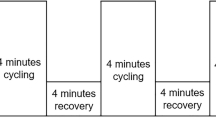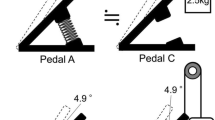Abstract
The aim of this study was to determine whether high inter-individual variability of the electromyographic (EMG) patterns during pedaling is accompanied by variability in the pedal force application patterns. Eleven male experienced cyclists were tested at two submaximal power outputs (150 and 250 W). Pedal force components (effective and total forces) and index of mechanical effectiveness were measured continuously using instrumented pedals and were synchronized with surface electromyography signals measured in ten lower limb muscles. The intersubject variability of EMG and mechanical patterns was assessed using standard deviation, mean deviation, variance ratio and coefficient of cross-correlation (\( \overline {R_{0} } , \) with lag time = 0). The results demonstrated a high intersubject variability of EMG patterns at both exercise intensities for biarticular muscles as a whole (and especially for Gastrocnemius lateralis and Rectus femoris) and for one monoarticular muscle (Tibialis anterior). However, this heterogeneity of EMG patterns is not accompanied by a so high intersubject variability in pedal force application patterns. A very low variability in the three mechanical profiles (effective force, total force and index of mechanical effectiveness) was obtained in the propulsive downstroke phase, although a greater variability in these mechanical patterns was found during upstroke and around the top dead center, and at 250 W when compared to 150 W. Overall, these results provide additional evidence for redundancy in the neuromuscular system.







Similar content being viewed by others
References
Bernstein N (1967) Coordination and regulation of movements. Pergamon Press, New York
Buchanan TS, Lloyd DG, Manal K, Besier TF (2004) Neuromusculoskeletal modeling: estimation of muscle forces and joint moments and movements from measurements of neural command. J Appl Biomech 20:367–395
Burden AM, Trew M, Baltzopoulos V (2003) Normalisation of gait EMGs: a re-examination. J Electromyogr Kinesiol 13:519–532. doi:10.1016/S1050-6411(03)00082-8
Cavanagh PR, Komi PV (1979) Electromechanical delay in human skeletal muscle under concentric and eccentric contractions. Eur J Appl Physiol Occup Physiol 42:159–163. doi:10.1007/BF00431022
Chapman AR, Vicenzino B, Blanch P, Hodges PW (2007) Patterns of leg muscle recruitment vary between novice and highly trained cyclists. J Electromyogr Kinesiol 18(3):359–371
Dal Monte A, Manoni A, Fucci S (1973) Biomechanical study of competitive cycling: the forces exercised on the pedals. In: Press B (ed) Biomechanics III. pp 434–439
Dingwell JB, Ulbrecht JS, Boch J, Becker MB, O’Gorman JT, Cavanagh PR (1999) Neuropathic gait shows only trends towards increased variability of sagittal plane kinematics during treadmill locomotion. Gait Posture 10:21–29. doi:10.1016/S0966-6362(99)00016-8
Dorel S, Couturier A, Hug F (2008a) Influence of different racing positions on mechanical and electromyographic patterns during pedalling. Scand J Med Sci Sports (in press)
Dorel S, Couturier A, Hug F (2008b) Intra-session repeatability of lower limb muscles activation pattern during pedaling. J Electromyogr Kinesiol (in press)
Ericson M (1986) On the biomechanics of cycling. A study of joint and muscle load during exercise on the bicycle ergometer. Scand J Rehabil Med Suppl 16:1–43
Gregor RJ, Cavanagh PR, LaFortune M (1985) Knee flexor moments during propulsion in cycling—a creative solution to Lombard’s Paradox. J Biomech 18:307–316. doi:10.1016/0021-9290(85)90286-6
Gregor RJ, Komi PV, Browning RC, Jarvinen M (1991) A comparison of the triceps surae and residual muscle moments at the ankle during cycling. J Biomech 24:287–297. doi:10.1016/0021-9290(91)90347-P
Hermens HJ, Freriks B, Disselhorst-Klug C, Rau G (2000) Development of recommendations for SEMG sensors and sensor placement procedures. J Electromyogr Kinesiol 10:361–374. doi:10.1016/S1050-6411(00)00027-4
Hug F, Dorel S (2008) Electromyographic analysis of pedaling: a review. J Electromyogr Kinesiol (in press)
Hug F, Bendahan D, Le Fur Y, Cozzone PJ, Grelot L (2004) Heterogeneity of muscle recruitment pattern during pedaling in professional road cyclists: a magnetic resonance imaging and electromyography study. Eur J Appl Physiol 92:334–342. doi:10.1007/s00421-004-1096-3
Hull ML, Davis RR (1981) Measurement of pedal loading in bicycling: I. Instrumentation. J Biomech 14:843–856. doi:10.1016/0021-9290(81)90012-9
Kautz SA, Feltner ME, Coyle EF, Baylor AM (1991) The pedaling technique of elite endurance cyclists: changes with increasing workload at constant cadence. Int J Sport Biomech 7:29–53
LaFortune MA, Cavanagh PR (1983) Effectiveness and efficiency during cycling riding. In: Biomechanics VIII-B: international series on biomechanics. Human Kinetics. pp 928–936
Li L, Caldwell GE (1999) Coefficient of cross correlation and the time domain correspondence. J Electromyogr Kinesiol 9:385–389. doi:10.1016/S1050-6411(99)00012-7
Mirka GA (1991) The quantification of EMG normalization error. Ergonomics 34:343–352. doi:10.1080/00140139108967318
Rouffet DM, Hautier CA (2008) EMG normalization to study muscle activation in cycling. J Electromyogr Kinesiol (in press)
Rowe T, Hull ML, Wang EL (1998) A pedal dynamometer for off-road bicycling. J Biomech Eng 120:160–164. doi:10.1115/1.2834297
Ryan MM, Gregor RJ (1992) EMG profiles of lower extremity muscles during cycling at constant workload and cadence. J Electromyogr Kinesiol 2:69–80. doi:10.1016/1050-6411(92)90018-E
Sanderson DJ (1991) The influence of cadence and power output on the biomechanics of force application during steady-rate cycling in competitive and recreational cyclists. J Sports Sci 9:191–203
Sanderson DJ, Black A (2003) The effect of prolonged cycling on pedal forces. J Sports Sci 21:191–199. doi:10.1080/0264041031000071010
Sanderson DJ, Hennig EM, Black AH (2000) The influence of cadence and power output on force application and in-shoe pressure distribution during cycling by competitive and recreational cyclists. J Sports Sci 18:173–181. doi:10.1080/026404100365072
Shan G (2008) Biomechanical evaluation of bike power saver. Appl Ergon 39:37–45
Shiavi R, Bourne J, Holland A (1986) Automated extraction of activity features in linear envelopes of locomotor electromyographic patterns. IEEE Trans Biomed Eng 33:594–600. doi:10.1109/TBME.1986.325841
Shiavi R, Bugle HJ, Limbird T (1987) Electromyographic gait assessment, Part 1: adult EMG profiles and walking speed. J Rehabil Res Dev 24:13–23
van Bolhuis BM, Gielen CC (1999) A comparison of models explaining muscle activation patterns for isometric contractions. Biol Cybern 81:249–261. doi:10.1007/s004220050560
van Ingen Schenau GJ, Boots PJM, de Groots G, Snackers RJ, van Woensel WWLM (1992) The constrained control of force and position in multi-joint movements. Neuroscience 46:197–207. doi:10.1016/0306-4522(92)90019-X
Vos EJ, Mullender MG, van Ingen Schenau GJ (1990) Electromechanical delay in the vastus lateralis muscle during dynamic isometric contractions. Eur J Appl Physiol Occup Physiol 60:467–471. doi:10.1007/BF00705038
Winter DA, Yack HJ (1987) EMG profiles during normal human walking: stride-to-stride and inter-subject variability. Electroencephalogr Clin Neurophysiol 67:402–411. doi:10.1016/0013-4694(87)90003-4
Wren TA, Do KP, Rethlefsen SA, Healy B (2006) Cross-correlation as a method for comparing dynamic electromyography signals during gait. J Biomech 39:2714–2718. doi:10.1016/j.jbiomech.2005.09.006
Yang JF, Winter DA (1984) Electromyographic amplitude normalization methods: improving their sensitivity as diagnostic tools in gait analysis. Arch Phys Med Rehabil 65:517–521
Acknowledgments
This study was funded in part by “La fondation d’entreprise de la Française Des Jeux” and the French Ministry of Sport (contract no. 06-046). The authors are grateful for the subjects for having accepted to participate in this study.
Author information
Authors and Affiliations
Corresponding author
Rights and permissions
About this article
Cite this article
Hug, F., Drouet, J.M., Champoux, Y. et al. Interindividual variability of electromyographic patterns and pedal force profiles in trained cyclists. Eur J Appl Physiol 104, 667–678 (2008). https://doi.org/10.1007/s00421-008-0810-y
Accepted:
Published:
Issue Date:
DOI: https://doi.org/10.1007/s00421-008-0810-y




